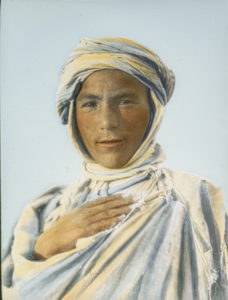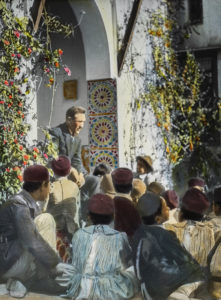 LS owns a box of approximately 75 hand colored glass magic lantern slides at 4’ x 3 ¼’ each. What are they? He had no idea they came from exotic 1930’s Morocco. With the help of Professor Allan Langdale, who teaches at UCSC, a friend of mine, we pieced together where many of these slides originated.
LS owns a box of approximately 75 hand colored glass magic lantern slides at 4’ x 3 ¼’ each. What are they? He had no idea they came from exotic 1930’s Morocco. With the help of Professor Allan Langdale, who teaches at UCSC, a friend of mine, we pieced together where many of these slides originated.
First, what is a magic lantern? These early types of image projectors, shined light through glass slides through the invention of the arc lamp in 1860. The slides were imprinted with the image, and hand colored with dense pigment. When projected these slides became visually compelling, radiant, a feast for the eyes in a time before TV.
The American Magic Lantern Theater of today says nothing comes close to the magic lantern slide. The impact of these slides upon audience continued into the beginning of the 20th century. By the 1940’s these became things of the past, although many libraries and museums have large collections.
One Person Shot LS’s Magic Lantern Slides
Dr Langdale suggests this person wasn’t a scholar of North Africa, but a tour guide around Fez, specifically of the Medina (Fez el Bali). We see the daily life in and around the old walled Fez medina, the former capital of modern Morocco, today a UNESCO World Heritage site.
I found a slide of the famous market’s entrance, the French-constructed “Blue Gate,” the Bab Bou Jeloud, built as an entrance to the medina in 1912. Once I identified that gate, I felt sure LS’s collection came from Morocco. Then I identified the Andalusia Mosque, old men having their mint tea, and village scenes of the Berbers (Amazighs).
Exceptional views showed a snow scene of the Atlas Mountains and secret Sufi Tombs. Also evidence of French control, as seen in a movie marquee in French for a Sherlock Holmes movie, and a donkey pulling a street car with the destination “C. le Bor.” I didn’t know roman ruins existed in Morocco, but Dr Langdale pronounced one slide a scene of Roman Volubilis, 1st century A.D.
Like all objects, these speak volumes about the maker, the unknown photographer. I asked Dr Langdale, who knows how period scholars documented such sites, if the person who shot the magic lantern slides aimed at scholarship or entertainment. Is this collection the work of a scholar in 1930, or the work of a tour guide who presented to the popular ladies’ groups of the era?
Dr Langdale calls these images cliché
They show the Moroccan people as exotic, simple, pure, and devout. These ethnographic type scenes appeared in early National Geographic magazines, in the genre called “orientalism.” Both the style and the theory of thought held fast in a time (1880-1920) when European eyes gazed romantically upon exotic cultures. The ‘other’ romanticized culture remained ‘other,’ and ‘unspoiled.’ Perhaps they considered more devout cultures more closely tied to the land and their communities, and more colorfully dressed, or undressed as was often the case, and more dashing. Fascinating to see in LS’s collection that the slides, the objects themselves, contain such a voice.
 In one slide you see a man dressed in a suit, in the blazing heat, raised above the white-robed exotic Berbers beneath him. He looks fondly down, lecturing. In another slide we see the map of North Africa, with the map of France above, titled “how big is France?” That slide says that French North Africa, although much larger than France, was “held” by the superiority of France (1912-1956). Think of the famous Bab Bou Jeloud, the gate to the Fez medina, built in the Moorish/Moroccan style BY the French. You get the idea of one culture overlaying ideology upon another.
In one slide you see a man dressed in a suit, in the blazing heat, raised above the white-robed exotic Berbers beneath him. He looks fondly down, lecturing. In another slide we see the map of North Africa, with the map of France above, titled “how big is France?” That slide says that French North Africa, although much larger than France, was “held” by the superiority of France (1912-1956). Think of the famous Bab Bou Jeloud, the gate to the Fez medina, built in the Moorish/Moroccan style BY the French. You get the idea of one culture overlaying ideology upon another.
The value of such a collection?
Because cases of these magic lantern slides were so common to lecturers of travelogue series, many cases exists. LS’s case of slides offers no more and no less than the expected views of Morocco: wonderful, quaint, exotic, with camels, mosques, tiled columned archways and men in robes. I put the value at $650 for the set. As a statement of how an object can speak of the biases inherent in a retelling of history, it’s invaluable.